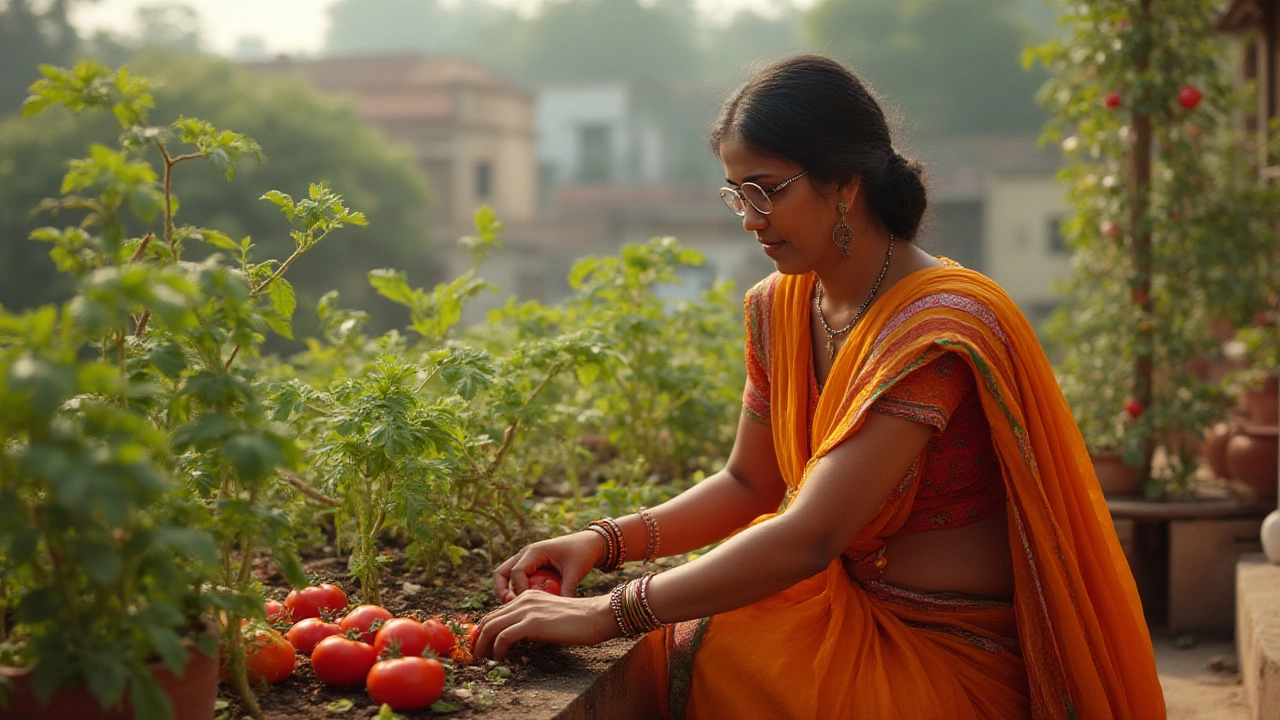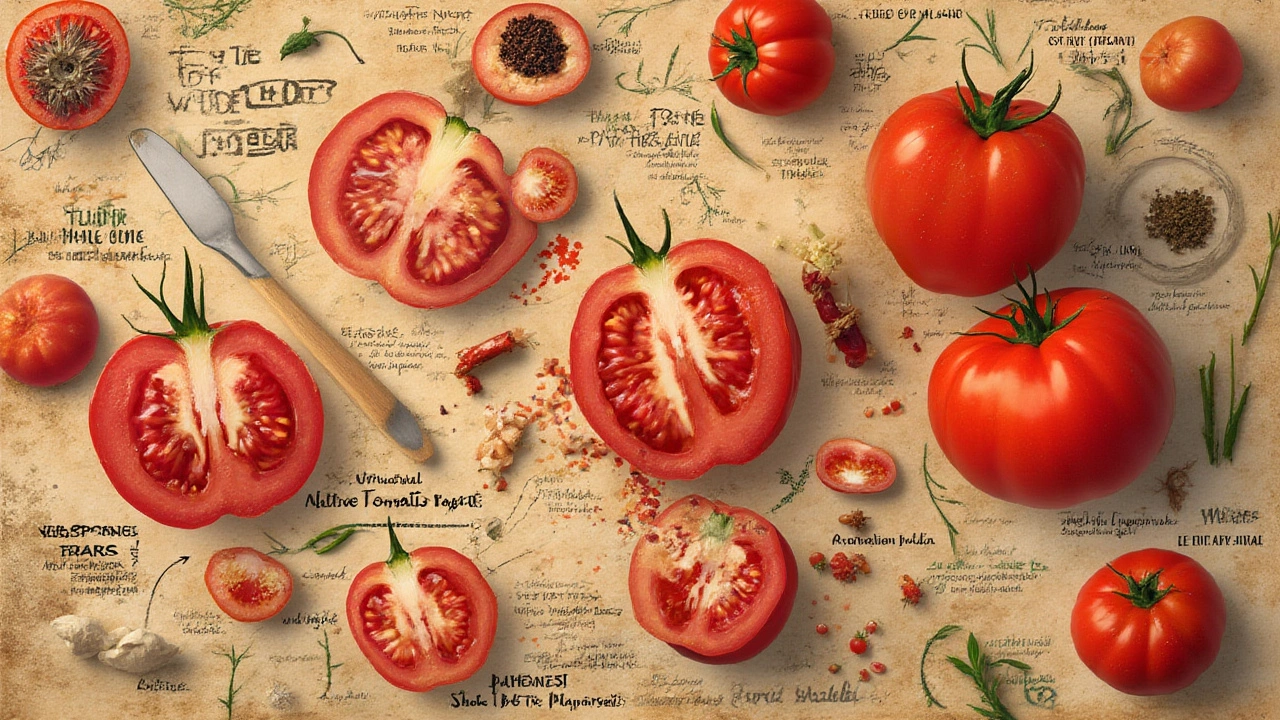Walk through any bustling Indian market: red, plump tomatoes shine everywhere, right alongside onions and potatoes. But here’s the kicker—despite their starring role in paneer butter masala and tangy chutneys, tomatoes aren’t actually native to India at all. This fact can surprise even regular gardeners and food lovers. So where did tomatoes come from, and how did they end up in just about every Indian dish? This rabbit hole has more twists than a Bollywood plot, so grab your chai and let’s sort this out together.
The Real Roots: Tracing the Global Origins of Tomatoes
Tomatoes look right at home growing next to coriander and chillies, but the truth is that their roots don’t trace back to Indian soil. Scientists have nailed down that the original tomato plants came from the rugged Andes mountains, straddling today’s Peru, Ecuador, and northern Chile. Wild tomatoes in these regions were small and tart—nothing like the plump varieties topping pizzas or sizzling in curries now. Indigenous peoples of South America, especially the Aztecs in Mexico, started cultivating and spreading the tomato as early as 500 BC. Linguistic clues help piece together this history: ‘Tomatl’ is the Nahuatl (Aztec) word for tomato—so that’s where the English word comes from.
Tomatoes took their sweet time getting recognized globally. While South Americans had tomatoes centuries ago, the rest of the world was blissfully tomato-less. It wasn’t until Spanish conquistadors showed up in the Americas in the 16th century that these novel fruits (yep, botanically a fruit) crossed the Atlantic. Spain and Portugal became the launch pads for tomatoes into Europe, Africa, and finally Asia.
Funny enough, when Europeans first saw tomatoes, they thought the bright red fruits were poisonous. Blame that on their relation to deadly nightshades. This reputation stuck around for a while, and even in Europe people grew tomatoes as decorative plants, not food. There’s a story from 17th century England about a man trying a tomato, convinced it would kill him—but he survived, obviously, and the world kept spinning.
Only after tomatoes spread through Mediterranean cuisine did people start to realize just how delicious and versatile they could be. Italy, can you imagine without pizza sauce or pasta? But Indians weren’t biting into tomatoes quite yet.
How Did Tomatoes Arrive in India?
So, if tomatoes hailed from the wilds of South America, how did they make their way into Indian cooking? This bit’s like a global relay race. Portuguese traders, famous for bringing in other non-natives like chillies, potatoes, and even cashew nuts, were the main players. After claiming a big chunk of western coastal India (Goa onward), the Portuguese set up trade posts and soon began sharing—and blending—new foods with locals. This happened roughly in the 16th and 17th centuries, a period when Indian vegetable markets were already a melting pot of imports and native produce.
Tomatoes, known regionally as ‘tamatar’ (Hindi), ‘thakkali’ (Tamil), ‘tamatam’ (Telugu) and other names, started to win hearts slowly. Initially, only communities closer to Portuguese influence—Goa, Kerala, parts of the western coast—used them. But recipes travel, and soon tomatoes got a starring role across the length and breadth of India. You’ll find them in everything from Bengali tomato chutney sweetened with jaggery to spicy Andhra tomato pappu and the unmistakable desi version of ketchup.
Apart from the Portuguese, British colonialists accelerated adoption, pushing tomatoes into northern regions by the nineteenth century. Back then, “foreign” vegetables (like cauliflowers and cabbages) were the latest thing—almost a sign of cosmopolitan cooking. Tomatoes slotted right in as western-educated Indians, urbanites, and chefs started picking them as an everyday staple.
One strange twist: not every part of India accepted tomatoes instantly. Traditionalists sometimes looked at new vegetables with suspicion, thinking of them as ‘vilayati’ (foreign), but flavor (and maybe convenience) won the battle in the end. That’s why you still find some classic Indian recipes, like dal tadka, listed both with and without tomato, depending on family and region.

The Tomato Today: Modern Indian Tomato Cultivation & Statistics
Toss a stone in rural India, and chances are it will land in a field with rows of tomato plants peeking up. India now ranks as one of the world’s top tomato producers, trailing only China. According to FAO data from recent years, Chinese farms harvested around 62 million tonnes of tomatoes, while India was closing in at 20 million tonnes every year. That’s a jaw-dropping increase for a plant that was a total outsider until just about three centuries ago!
The states leading tomato production in India are Andhra Pradesh, Madhya Pradesh, Karnataka, Gujarat, and Odisha. Andhra Pradesh used to be the heavyweight, but competition’s getting fierce because of rising demand and improvements in farming techniques everywhere. Summer varieties, hybrid options, and climate-smart methods have kicked off a boom in tomato farming, even in unexpected places like Maharashtra’s dry zones.
Take a look at this handy data table for recent breakdown (all numbers are 2022 estimates):
| State | Production (million tonnes) | Main Growing Season(s) |
|---|---|---|
| Andhra Pradesh | 6.4 | Rabi, Kharif |
| Madhya Pradesh | 2.7 | Rabi, Kharif |
| Karnataka | 2.1 | Rabi |
| Gujarat | 1.9 | Kharif |
| Odisha | 1.5 | Kharif |
Tech-savvy farmers have boosted yields with tricks like drip irrigation and greenhouse cultivation. Price fluctuations, driven by huge supply bursts and panicky demand changes, are an infamous part of India’s tomato story. Last year’s price surge—remember when memes about “tomato-rich” people flooded social media?—reminds us how central are tomatoes native to india is as a question. It’s not just nostalgia, but hard economics too.
Tomatoes in Indian Cuisine: Not Just a Vegetable
It’s kind of wild to think about, but Indian food—now jam-packed with tomatoes—was cooked for centuries without them. Consider old-school curries or lentil stews: they leaned on yogurt, amchur (dry mango powder), or tamarind for the tangy punch. Tomato-based gravies, as we know them today, are a recent phenomenon by comparison. The shift wasn’t instant, but India’s massive culinary machine moves fast when it wants to. Cooks soon discovered that tomatoes deliver not just acidity, but natural sugars that mellow out spicy, oily dishes.
Ever tried homemade tomato rasam? Or “bharwa tamatar” stuffed with paneer and spices? Each region mashed tomatoes into its signature combos. Restaurant-style dishes—like butter chicken, paneer makhani, pav bhaji, and tomato soup—just wouldn’t taste right without that signature red base. Imagine ketchup-doused samosas or chutneys at a breakfast table without tomatoes. Not the same, right?
And yet, tomato skeptics are still out there. Some say tomatoes mask the taste of real spices if used too much. Pickle experts whip up “no tomato” versions that rely on lime or raw mango. If you want that authentic pre-tomato taste, you can still try dal with amchur or yogurt for tang.
Surprisingly, tomatoes didn’t take over every dish. Many south Indian filter coffee houses stick to coconut-based gravies, while eastern delicacies lean on local greens or pungent mustards. Tomatoes are flexible, but India’s cuisines have never been one-size-fits-all—that’s the beauty of it.

Growing Tomatoes in Indian Gardens: Tips & Tricks for a Bountiful Harvest
Whether you’re a city dweller working with pots on a sunny balcony or a rural gardener wrangling a whole field, tomatoes thrive just about anywhere in India. First things first: pick the right variety for your spot. Plum tomatoes (Roma, San Marzano), cherry tomatoes, or Indian hybrids like Pusa Ruby—each type suits different recipes and climates.
Good tomatoes crave lots of sun. Give them 6–8 hours of light daily, and they’ll reward you. Indian summers can be brutal, so partial shade is your friend in the hottest zones. Tomatoes aren’t fussy about soil, but they adore loose, loamy dirt enriched with compost or aged manure. Mix in wood ash if your soil is acidic, and always mulch to preserve moisture.
Water is a big deal. Drip irrigation is popular with modern farmers, but if you’re working by hand, water early in the morning to lower the risk of fungal diseases. Tomatoes hate ‘wet feet’—make sure your pots or beds drain well. Stake your plants early; bamboo sticks, PVC pipes, or even old mop handles work in a pinch. This keeps fruits off the soil and away from pests.
Watch out for leaf curl, blossom end rot, and fruit borers—the main tomato headaches in India. Neem oil, introducing beneficial insects like ladybirds, and crop rotation all help. Companion planting with basil or garlic can keep bugs away, plus they look pretty mixed in the same pot. Harvest when fruits are firm and red; don’t wait for every fruit to ripen on the vine, or you’ll invite birds and rot.
Save seeds from your tastiest fruits for next season—just scoop, wipe, and dry. Swap seeds with gardening friends to discover new local strains; you might land a flavor bomb unavailable in stores. And by growing even a couple of pots of tomatoes, you join a centuries-long, globe-spanning story. Not bad for a so-called “foreign” import, right?

